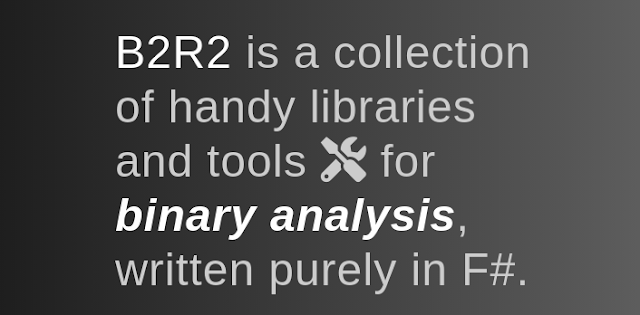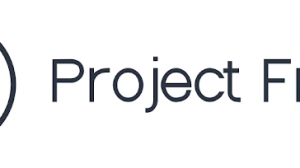[sc name=”ad_1″]
B2R2 is a collection of useful algorithms, functions, and tools for binary analysis, written purely in F# (in .NET lingo, it is purely managed code).
B2R2 has been named after R2-D2, a famous fictional robot appeared in the Star Wars. In fact, B2R2’s original name was B2-R2, but we decided to use the name B2R2 instead, because .NET does not allow dash (-) characters in identifiers (or namespaces).
The name essentially represents “binary” or “two”: “binary” itself means “two” states anyways. “B” and “2” mean “binary”, and “R” indicates reversing.
B2R2?
- B2R2 is analysis-friendly: it is written in F#, which provides all the syntactic goodies for writing program analyzers, such as pattern matching, algebraic data types, and etc.
- B2R2 is fast: it has a fast and efficient front-end engine for binary analysis, which is written purely in a functional way. Therefore, it naturally supports pure parallelism for binary disassembling, lifting and IR optimization.
- B2R2 is easy to play with: there is absolutely no dependency hell for B2R2 because it is a fully-managed library. All you need to do is to install .NET Core SDK, and you are ready to go! Native IntelliSense support is another plus!
- B2R2 is OS-Independent: it works on Linux, Mac, Windows, and etc. as long as .NET core supports it.
- B2R2 is interoperable: it is not bound to a specific language. Theoretically, you can use B2R2 APIs with any CLI supported languages.
Features?
Currently, our focus is on the front-end of binary analysis, which includes binary parser, lifter, and optimizer. B2R2 natively supports parallel lifting, which is a new technique we introduced in 2019 NDSS Bar. Please refer to our paper for more details about the technique as well as our design decisions. We also have our own back-end tools such as symbolic executor, but we are not planning to open-source them yet. Nevertheless, B2R2 includes several useful middle-end or back-end features such as ROP chain compilation, CFG building, and automatic graph drawing, and etc. B2R2 also comes with a simple command-line utility that we call BinExplorer, which can help explore such features using a simple command line interface.
Dependencies?
B2R2 relies on a tiny set of external .NET libraries, and our design principle is to use a minimum number of libraries. Below is a list of libraries that we leverage.
API Documentation
We currently use docfx to generate our documentation: https://b2r2.org/APIDoc/
Example
Let’s try to use B2R2 APIs.
- First we create an empty directory
DIRNAME:mkdir DIRNAME - We then create an empty console project with
dotnetcommand line:$ dotnet new console -lang F# - Add our nuget package B2R2.FrontEnd to the project:
$ dotnet add package B2R2.FrontEnd - Modify the
Program.fsfile with your favorite editor as follows:open B2R2 open B2R2.FrontEnd[<EntryPoint>] let main argv = let isa = ISA.OfString "amd64" let bytes = [| 0x65uy; 0xffuy; 0x15uy; 0x10uy; 0x00uy; 0x00uy; 0x00uy |] let handler = BinHandler.Init (isa, bytes) let ins = BinHandler.ParseInstr handler 0UL ins.Translate handler.TranslationContext |> printfn "%A" 0 - We then just run it by typing:
dotnet run. You will be able see lifted IR statements from your console. That’s it! You just lifted an Intel instruction with only few lines of F# code!
Build
Building B2R2 is fun and easy. All you need to do is to install .NET Core SDK 3.0 or above. Yea, that’s it!
- To build B2R2 in release mode, type
make releaseordotnet build -c Releasein the source root. - To build B2R2 in debug mode, type
make, ordotnet buildin the source root.
For your information, please visit the official web site of F# to get more tips about installing the development environment for F#: http://fsharp.org/.
Why Reinventing the Wheel?
There are many other great tools available, but we wanted to build a functional-first binary analysis platform that is painless to install and runs on any platform without any hassle. B2R2 is in its infancy stage, but we believe it provides a rich set of library functions for binary analysis. It also has a strong front-end that is easily adaptable and extendible! Currently it reliably supports x86 and x86-64, meaning that we have heavily tested them; and it partially supports ARMv7 (and Thumb), ARMv8, MIPS32, and MIPS64, meaning that they work, but we haven’t tested them thorougly yet.
Features to be Added?
Below is a list of features that we plan to add in the future: the list is totally incomplete. Some of them are work in progress, but we look forward your contributions! Feel free to write a PR (Pull Requst) while making sure that you have read our contribution guideline.
- Implement CFG recovery algorithms.
- Implement assembler for currently supported ISAs using a parser combinator.
- Support for floating point operations.
- Support for more architectures such as PPC.
Credits
Members in SoftSec Lab. @ KAIST developed B2R2 in collaboration with Cyber Security Research Center (CSRC) at KAIST. See Authors for the full list.
[sc name=”ad-in-article”]





















Add Comment